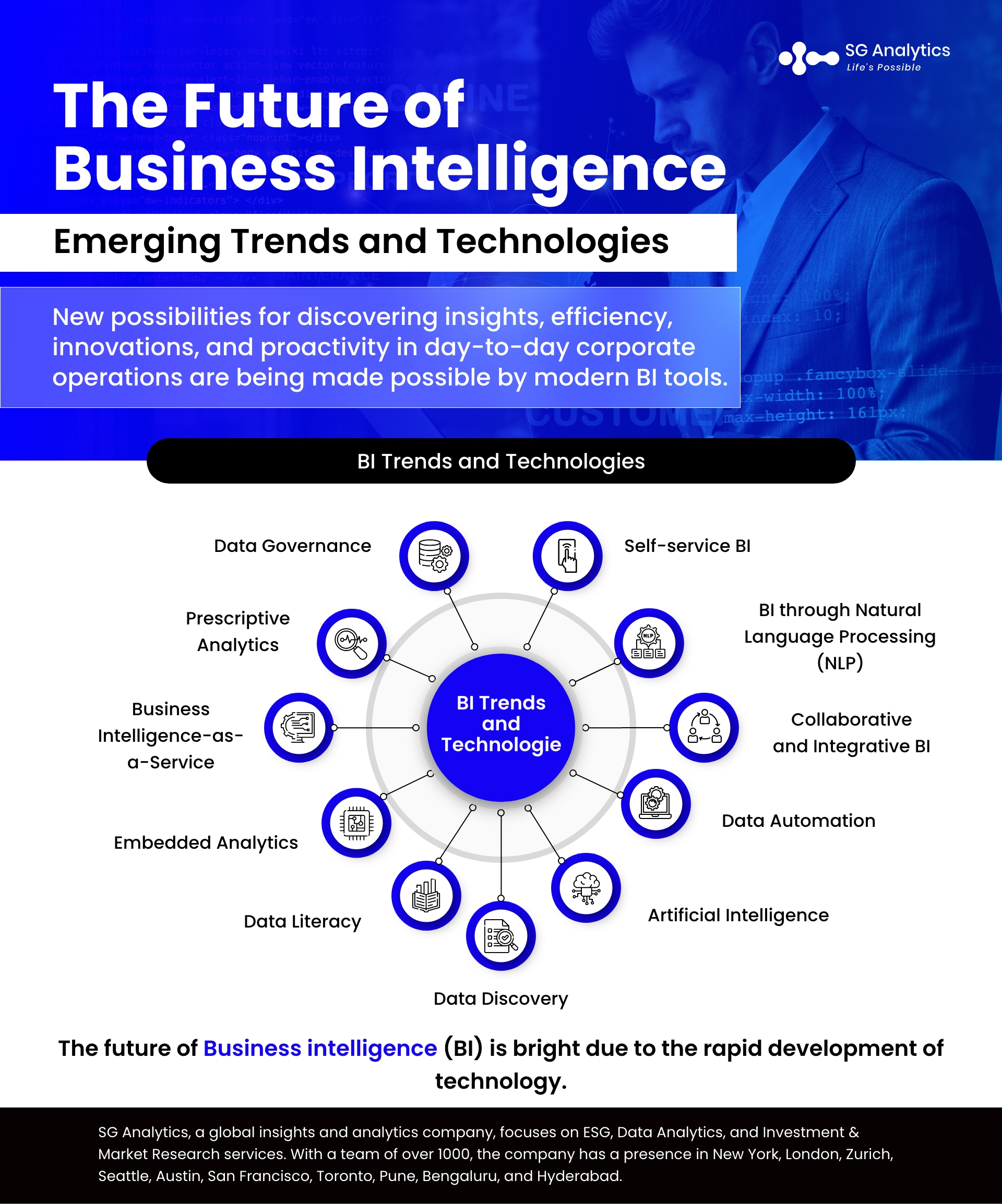Data never stops, and neither does business. Amidst global socio-economic crises like the COVID-19 pandemic, business intelligence is more critical now than ever for enterprises to survive and thrive. How will the business intelligence industry be disrupted by trends such as automation, the cloud, and mobile analytics in the coming year and beyond?
Business intelligence has seen a dramatic transformation during the past decade. The quantity and variety of data grew rapidly. And like that, everyone may join the cloud. Data visualizations and interactive corporate dashboards have surpassed spreadsheets as the go-to tools for data analysis and decision-making. Data product chain accessibility increased with the development of self-service analytics. Suddenly, non-analysts could also benefit from using advanced analytics.
New possibilities for the discovery of insights, efficiency, innovations, and proactivity in day-to-day corporate operations are made possible by modern BI tools. The BI market is predicted to reach $33.3 billion by 2025, thanks to the numerous features of BI software.
Business intelligence has seen a dramatic transformation during the past decade. The quantity and variety of data grew rapidly. And like that, everyone may join the cloud. Data visualizations and interactive corporate dashboards have surpassed spreadsheets as the go-to tools for data analysis and decision-making. Data product chain accessibility increased with the development of self-service analytics.

There will be a shift towards more individualized BI tools and approaches. When it comes to business intelligence, the question isn't whether or not a company needs better access to analytics but rather which BI solution will work best for them.
With the support of contemporary BI dashboard software, businesses no longer ponder if visualizations enhance analyses but rather what is the best method to convey each data story.
BI Trends and Technologies
Data Governance
The importance of data quality management has grown as legislation concerning data privacy, and security has become more stringent. In the coming years, businesses will make concerted efforts to categorize their data so they can better understand its provenance, who has access to it, how it's being used, and for how long it can be stored.
Data governance will rise to the forefront of business intelligence initiatives at companies of all sizes. The exponential growth of analytics programmes will also play a role in this, as will the variety of data sources and types that will be required to support those activities.
The return on investment (ROI) from BI efforts can be maximized through the use of a data governance approach that allows for parity between data consistency and openness. In turn, this will lay the groundwork for making decisions that are correct, ethical, and supported by evidence.
Insight into the data requirements of a business can be gained through good data governance. This will provide privacy, secrecy, and the prevention of unauthorized usage, while also improving the quality of data and information in general.
Business intelligence (BI) decision-making can then be guided by accurate data, leading to better business outcomes. In addition, it will guarantee that data is collected safely from reliable sources, used appropriately, communicated to the right people, and deleted on schedule.

Self-service BI
As the business world embraces more and more advanced technologies, employees have come to demand instantaneous access to all of the information they need, regardless of where they happen to be. They'd rather not rely on the analytics team for every solution; they want to find their own. Now that information from all departments is in one place, employees are eager to apply it in whatever way they see fit.
Self-service business intelligence (BI) is growing in popularity and will soon be the standard in most organizations around the world. BI gives employees the information they need to solve complex issues quickly and efficiently. It will also improve the organization's overall ability to make decisions by providing all users with access to the same reliable data.
A self-service data model will empower business users to become self-sufficient since they will know exactly what they need. Users will improve their data utilization in the coming years, laying the groundwork for a data-driven culture across the entire organization. With self-service BI, users no longer have to wait for IT or data teams to get the information they need to complete their analyses and make important decisions.
Prescriptive Analytics
While predictive analytics has long been a staple of business intelligence (BI), helping companies mine existing data for insights into the future, prescriptive analytics is expected to become a mainstream phenomenon in the coming years.
To find the best course of action for accomplishing a specific objective, prescriptive analytics analyses data or content. It will help businesses make better decisions by allowing them to foresee potential outcomes and make necessary adjustments before committing to a course of action.
Over the next few years, businesses will increasingly employ prescriptive analytics to take into account a variety of scenarios, resources, and outcomes to determine the optimal next steps. Instead of making hasty assumptions, they will carefully consider all of the information at hand before making a decision.

BI through Natural Language Processing (NLP)
The development of natural language processing (NLP) is unprecedented because of the increasing complexity of interactions between humans and technology. Enterprises will improve business results to achieve a more significant competitive advantage in the coming years, even if smart voice assistants have long responded to users through NLP.
A few years from now, natural language processing (NLP) will be utilized in sectors outside of customer service as well. For instance, NLP will help employees who aren't tech-knowledgeable to better understand and use complex digital tools and systems. In addition, it will make it simpler for non-technical users to connect to data that is based on business intelligence.
Businesses will use natural language processing to gauge the favorable (or negative) social media buzz about their brand, analyze client feelings, and extract relevant information from text. The next step in this technology's evolution is chatbots driven by artificial intelligence, which will answer consumers' BI questions in a flash.
Business Intelligence-as-a-Service
The field of business intelligence and data analytics is not immune to the XaaS model's pervasiveness, either. Businesses with massive data stores that struggle to extract useful information from their data will likely investigate available BI-as-a-Service solutions. This structure will provide all the advantages of a comprehensive BI solution, including cloud deployment simplicity, to the user.
By outsourcing hard analysis tasks, businesses will have a BI solution up and operating in no time with BI-as-a-Service. The concept will make it possible for businesses to affordably gain access to knowledgeable BI consultants and data architects who can manage and govern their data for optimal business outcomes.
With Business Intelligence as a Service, companies can have trained professionals efficiently gather information from a variety of sources, clean and analyze the ever-expanding trove of data, and deliver the results of their analysis in user-friendly dashboards and reports. Since they have a limited number of data scientists, the end-to-end solution will help them overcome bottlenecks while also empowering regular users to generate their own reports and dashboards.

Collaborative and Integrative BI
Collaborative and integrated BI will gain traction in the market during the next few years. Rather than having to buy and implement separate business intelligence (BI) solutions, most enterprise systems will have BI capabilities baked in, allowing users to discover insights and make choices without leaving the platform.
The next generation of BI systems will be built with more users in mind and will have tighter integration with enterprise-level software. They will continuously collect data from all relevant sources, combine it, conduct in-depth analysis, and deliver actionable insights to users in near real-time. Alerts can be sent to users via these systems, keeping them abreast of any new information.
Teams of workers will be able to go about their daily tasks and make judgments based on the examination of data in real time as these technologies become more and more integrated into current and future workflows. Data analysis within existing systems is just the beginning; they will also interact easily with third-party systems, laying the groundwork for a data-driven culture across the entire business.
Embedded Analytics
Data analytics is said to be "embedded" when it happens as part of a user's normal process. Embedding BI components like dashboards and reports within an organization's own application has been seen as a promising way to enhance decision-making and boost productivity.
Once stifled by spreadsheets, businesses are now seeing how embedded dashboards may help them deliver more value from within their own software. In 2023, more businesses will adopt the use of embedded analytics in all aspects of their operations, from the creation of sales reports to the distribution of various dashboards to clients.
Department heads and business owners alike are on the lookout for turnkey methods to deliver data without having to code their own applications. Organizations can provide more professional-looking reports and presentations to customers by simply "white labeling" the selected application.

Data Automation
Data (analysis) automation is essential to any discussion about business intelligence. Companies and organizations have been actively searching for cutting-edge data automation solutions to deal with the enormous amounts of data they have amassed in the last decade.
Businesses still face challenges due in part to the use of dozens of different tools and sources. By providing tools for discovering, analyzing, measuring, monitoring, and evaluating massive amounts of data, BI has made it possible for users to centralize all the data managed by an organization.
The proliferation of automation options made possible by business intelligence will only increase by 2023. Slowly but surely, silos between data scientists and business users are being broken down to provide a centralized hub for all of an organization's data needs, including but not limited to: data collection, analysis, monitoring, reporting, and sharing.
One example is intelligent reporting, which makes it possible for business users to automate data processing tasks independently of the IT department by means of tools like predictive analytics and automated reports. However, complicated studies that require human scripting and coding will still be handled by data scientists.
Data Literacy
With data increasingly serving as the basis for strategic decisions, it is crucial that businesses of all stripes learn to make sense of it and transform it into a collaborative tool that can be used by all employees.
Data literacy is proficiency with reading, writing, and communicating data in a specific context. This requires knowledge not only of the data but also of the methods, resources, and technology used in deducing meaning from it.
Even though there are many self-service solutions available, data literacy is still essential for a successful data-driven culture. It is the responsibility of the company's leadership to offer the necessary training and resources to guarantee that all workers are prepared to work with data and analytics. For data literacy to be implemented effectively, an assessment of both worker and management skills is required.
Long-term, with the right training and resources, people of various backgrounds will be able to perform complex analyses and use data as their primary language. Predictive analytics and other data science tools are becoming more widely available, freeing up experts to focus on more challenging projects.

Artificial Intelligence
The ultimate goal of artificial intelligence is to give machines the ability to perform complex tasks that were once only possible with human intelligence. The way we engage with analytics and data management is evolving as a result of AI. The report foresees an uptick in the application of engineering and hyper-automation with AI, with a focus on vulnerabilities in the area of security.
Businesses might benefit from rapid alerts about any unanticipated incidents and current events. Business intelligence (BI) systems using AI can do a complete and thorough analysis of any information with minimal human intervention.
You can get reports at any moment on the company's development, trends, forecast, anomalies, what-if analysis, value drivers, significant segment correlations, and so on. Generative adversarial networks (GANs) make it possible for AI to replace CAPTCHA and other forms of online verification.
Data Discovery
The word "data discovery" is used to describe the action of identifying patterns, relationships, and outliers within data. Information gleaned from numerous internal and external sources is presented via data visualization and advanced analytics.
Key stakeholders can be kept interested in the data if they can quickly extract insights and conduct in-depth studies without the need for special training. There has been a rise in demand for data discovery tools in organizations of all sizes due to the rising demand for data utilization and insights.
To generate insights that add value to the organization, it is necessary to understand the relationship between data through guided, advanced analytics, visual analysis, and data preparation.

Online data visualization and discovery tools are making business decision-making processes more environmentally friendly. Using the extensive and interactive reports or sales charts provided with numerous graphs, teams will be able to find key anomalies and trends in a matter of minutes.
Also read - The Future of Business Intelligence: Top Trends for 2023 and Beyond.
Conclusion
Current BI trends will inevitably develop further, as will all technologies. Historically, business intelligence (BI) has been limited to data-filled spreadsheets; today, however, technology permits meaningful visualization and immediate action. As a result of BI, businesses now have access to cutting-edge methods for boosting output, expanding revenue, and gaining insights into their clientele.
The future of business intelligence (BI) is bright due to the rapid development of technology. To get the most out of BI, however, you need to anticipate future developments, figure out whether and how they may be incorporated, and plan out a strategy for integrating technology throughout your organization.
The goal of every organization today is to master data governance. The way in which businesses collect data is influenced by mobile insight, which makes up a sizable portion of business intelligence.

Pre-packaged industry verticals with customization possibilities are the current focus of vendors as cloud computing eclipses traditional BI solutions. Data science knowledge is still a rarity, but self-service BI is on the rise. The use of automation to facilitate business intelligence and analytics while freeing up your time is here to stay.
Visualize your data with impact and clarity through our data visualization services and solutions. At SGA, we embrace a design thinking approach to create intuitive and impactful visualizations that effectively communicate insights. Our skilled team offers business intelligence services, proficient in a wide range of industry-leading tools, and crafts bespoke visualizations that cater to your unique requirements.
From interactive dashboards that provide real-time insights to engaging reports that highlight key metrics, we deliver data visualizations that empower you to uncover meaningful patterns, identify trends, and drive data-informed decision-making. Transform your data into actionable insights and gain a competitive edge with our data visualization services.
What developments have the potential to shake up the BI industry? Have we overlooked any major developments in BI? What do you think? Tell us in the comments!









